

SS-304 Specifications
Page Back
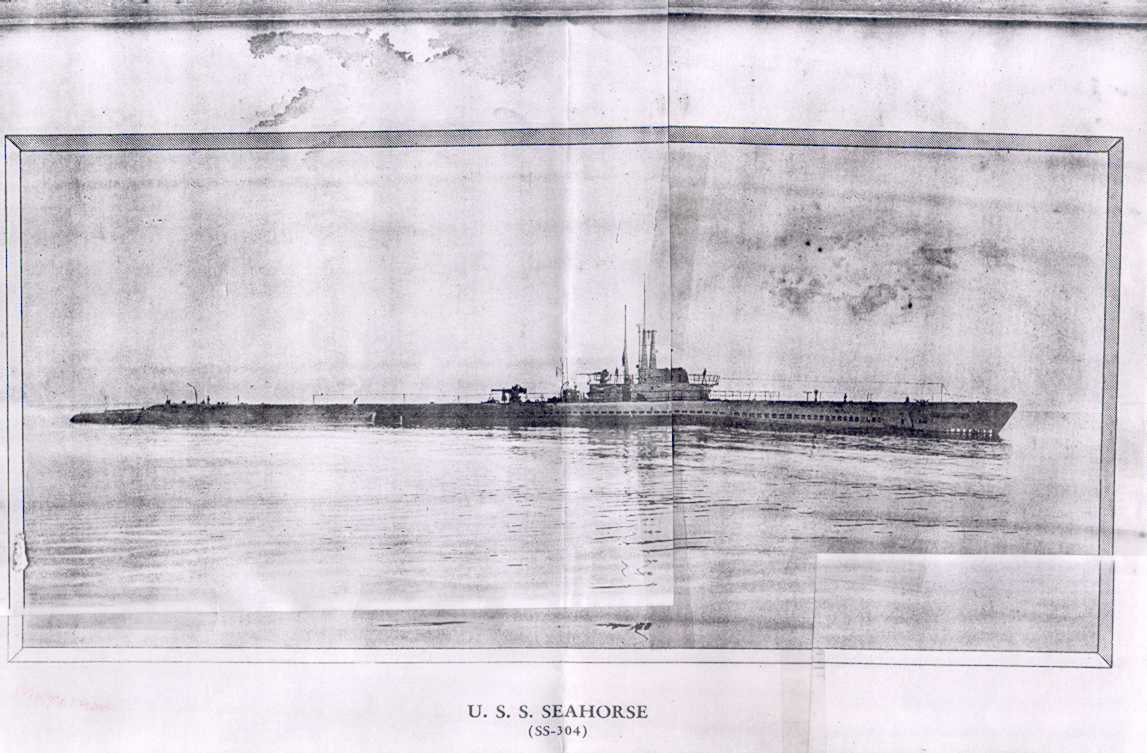
USS SEAHORSE (SS-304) was laid down on
August 1, 1942 at the Mare Island Navy Yard. She was launched January 9, 1943, sponsored
by Mrs. Chester C. Smith and commissioned March 31, 1943 with CDR
The first Seahorse war patrol was from 3 August to 27 September 1943. On the morning of
29 August while gaining attack position on an enemy convoy, she was detected by escorts
and suffered damage from a depth charge attack. She scored three torpedo hits on a
transport and then went deep to evade the ensuing attack which caused several leaks and
put one torpedo tube out of commission.
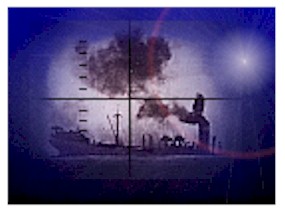 Following refit, Seahorse sailed
on 20 October for her second war patrol. She sank three enemy trawlers in surface actions
and then, along with the USS Trigger commenced a two day attack on a 17 ship Japanese
convoy. Seahorse evaded three escort ships and fired three torpedos at two freighters.
Four hours later she again attacked, sending three more torpedos at a tanker and another
spread at a third freighter. Flames burst from each target as Japanese destroyers turned
towards Seahorse but they were too late to catch her. Seahorse expended the last of her
torpedos on 30 November. After manuevering for several hours she was finally able to fire
her stern tubes at the enemy convoy. However, one torpedo exploded close aboard and the
convoy opened fire on the vicinity of Seahorse. With so many explosions around her, it was
impossible for her to determine whether any torpedos had hit. Low on fuel and out of
torpedos, she returned to Pearl Harbor.
Following refit, Seahorse sailed
on 20 October for her second war patrol. She sank three enemy trawlers in surface actions
and then, along with the USS Trigger commenced a two day attack on a 17 ship Japanese
convoy. Seahorse evaded three escort ships and fired three torpedos at two freighters.
Four hours later she again attacked, sending three more torpedos at a tanker and another
spread at a third freighter. Flames burst from each target as Japanese destroyers turned
towards Seahorse but they were too late to catch her. Seahorse expended the last of her
torpedos on 30 November. After manuevering for several hours she was finally able to fire
her stern tubes at the enemy convoy. However, one torpedo exploded close aboard and the
convoy opened fire on the vicinity of Seahorse. With so many explosions around her, it was
impossible for her to determine whether any torpedos had hit. Low on fuel and out of
torpedos, she returned to Pearl Harbor.
 Seahorse departed on 6 January 1944 for her third war patrol. On 16
January, she evaded four escorts and destroyed the cargo ship Nikko Maru. She spent 21
January tracking two enenmy cargo ships and three escorts. In the late evening she pressed
home four attacks to sink the cargo ship Yasukuni Maru, and the passenger-cargo ship Ikoma
Maru. On the evening of 28 January, Seahorse began an 80 hour chase of an enemy convoy.
Being continually harassed by escorts and aircraft, Seahorse fired three torpedos at the
cargo ship Toka Maru. Following the sinking, she lost contact with the convoy for several
hours, but sighted it again at dawn. With the crew exhausted by the extended chase, she
fired her final two torpedos. After evading the escorts, she surfaced in time to see the
results of her latest attack as the cargo ship Toei Maru slipped beneath the waves.
Seahorse departed on 6 January 1944 for her third war patrol. On 16
January, she evaded four escorts and destroyed the cargo ship Nikko Maru. She spent 21
January tracking two enenmy cargo ships and three escorts. In the late evening she pressed
home four attacks to sink the cargo ship Yasukuni Maru, and the passenger-cargo ship Ikoma
Maru. On the evening of 28 January, Seahorse began an 80 hour chase of an enemy convoy.
Being continually harassed by escorts and aircraft, Seahorse fired three torpedos at the
cargo ship Toka Maru. Following the sinking, she lost contact with the convoy for several
hours, but sighted it again at dawn. With the crew exhausted by the extended chase, she
fired her final two torpedos. After evading the escorts, she surfaced in time to see the
results of her latest attack as the cargo ship Toei Maru slipped beneath the waves.
 Seahorse's fourth war patrol
was conducted in the Marianas. Intercepting a large convoy on 8 April, she fired four
torpedos, sinking the converted seaplane tender Aratama Maru. Shortly thereafter, her
second spread of torpedos sank the caro ship Kizagawa Maru. Although a counter attack
drove Seahorse from the vicinity, she quickly regained contact and sank the cargo ship
Bisaka Maru. Seahorse took up lifeguard stations for airstrikes on Saipan on 12 April and,
while west of Saipan on 20 April, sighted and sank the Japanese submarine RO-45. In the
same vicinity a week later, Seahorse sank the cargo ship Akigawa Maru. She departed her
lifeguard station on 3 May and arrived at Brisbane, Australia on 11 May.
Seahorse's fourth war patrol
was conducted in the Marianas. Intercepting a large convoy on 8 April, she fired four
torpedos, sinking the converted seaplane tender Aratama Maru. Shortly thereafter, her
second spread of torpedos sank the caro ship Kizagawa Maru. Although a counter attack
drove Seahorse from the vicinity, she quickly regained contact and sank the cargo ship
Bisaka Maru. Seahorse took up lifeguard stations for airstrikes on Saipan on 12 April and,
while west of Saipan on 20 April, sighted and sank the Japanese submarine RO-45. In the
same vicinity a week later, Seahorse sank the cargo ship Akigawa Maru. She departed her
lifeguard station on 3 May and arrived at Brisbane, Australia on 11 May.
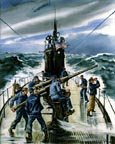 Seahorse's fifth war
patrol began on 11 June 1944, patrolling between Formosa and Luzon. On 13 June, a Japanese
Task Force under VADM Ukagi Matome set sail to rendezvous with additional elements of the
Japanese fleet to attack the U.S. invasion fleet off the Marianas. However, on 15 June, at
1622, Ugaki was sighted east of Mindanao and later reported by USS Seahorse.
Seahorse’s report helped U.S. intelligence put together a picture of the strength and
disposition of the approaching Japanese forces. The information later led to the
"Great Mariana's Turkey Shoot" during which the U.S. broke the back of Japanese
naval aviation. On the morning of 27 June, she sank the tanker Medan Maru and damaged two
other enemy vessels. On 3 July, she sank the carg ship Nitto Maru and the passenger-cargo
ship Gyoyu Maru. The following day, Seahorse expended the last of her torpedos sinking the
cargo ship Kyodo Maru No.28 and returned to Pearl Harbor on 19 July.
Seahorse's fifth war
patrol began on 11 June 1944, patrolling between Formosa and Luzon. On 13 June, a Japanese
Task Force under VADM Ukagi Matome set sail to rendezvous with additional elements of the
Japanese fleet to attack the U.S. invasion fleet off the Marianas. However, on 15 June, at
1622, Ugaki was sighted east of Mindanao and later reported by USS Seahorse.
Seahorse’s report helped U.S. intelligence put together a picture of the strength and
disposition of the approaching Japanese forces. The information later led to the
"Great Mariana's Turkey Shoot" during which the U.S. broke the back of Japanese
naval aviation. On the morning of 27 June, she sank the tanker Medan Maru and damaged two
other enemy vessels. On 3 July, she sank the carg ship Nitto Maru and the passenger-cargo
ship Gyoyu Maru. The following day, Seahorse expended the last of her torpedos sinking the
cargo ship Kyodo Maru No.28 and returned to Pearl Harbor on 19 July.
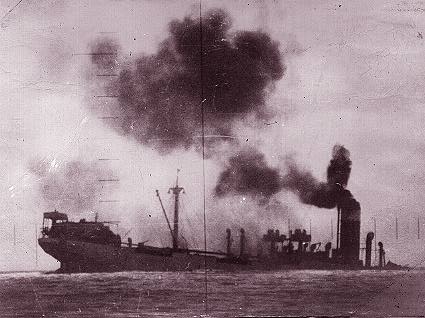 Seahorse
spent the first part of her sixth war patrol supporting the capture of the Palaus and then
headed for the Luzon Strait. Despite intensive efforts, she could locate only one
worthwhile target, Coastal Defense Vessel No.21, a frigate of 800 tons, which she sank.
Five days later she took up lifeguard station for carrier airstrikes on northern Luzon and
then returned to Midway on 18 October.
Seahorse
spent the first part of her sixth war patrol supporting the capture of the Palaus and then
headed for the Luzon Strait. Despite intensive efforts, she could locate only one
worthwhile target, Coastal Defense Vessel No.21, a frigate of 800 tons, which she sank.
Five days later she took up lifeguard station for carrier airstrikes on northern Luzon and
then returned to Midway on 18 October.
Upon completion of an overhaul at Mare Island Navy Yard, Seahorse put to sea on 9 March
1945 for her seventh war patrol. Patrolling in the Tushima Strait, she sank a small junk
with gunfire on 8 April. On 18 April, an attack by two patrol boats left the interior of
the submarine a shambles. Seahorse made hasty repairs and headed for Apra Harbor, Guam and
then to Pearl Harbor for overhaul.
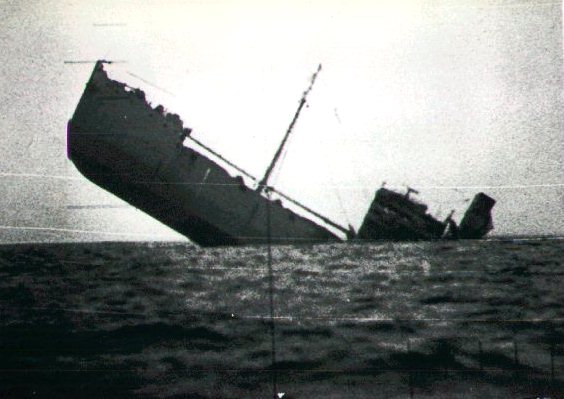 Seahorse put to sea for her eighth and final war patrol on 12 July 1945. when hostilities
ceased on 15 August, she was on station 40 miles southeast of Hachijo Shima. Following her
return to Midway, Seahorse sailed for Mare Island where she was decommissioned on 2 March
1946. She was reclassified an auxiliary submarine on 6 November 1962, and struck from the
navy list on 1 March 1967. Seahorse received nine battle stars for service in WWII.
Seahorse put to sea for her eighth and final war patrol on 12 July 1945. when hostilities
ceased on 15 August, she was on station 40 miles southeast of Hachijo Shima. Following her
return to Midway, Seahorse sailed for Mare Island where she was decommissioned on 2 March
1946. She was reclassified an auxiliary submarine on 6 November 1962, and struck from the
navy list on 1 March 1967. Seahorse received nine battle stars for service in WWII.